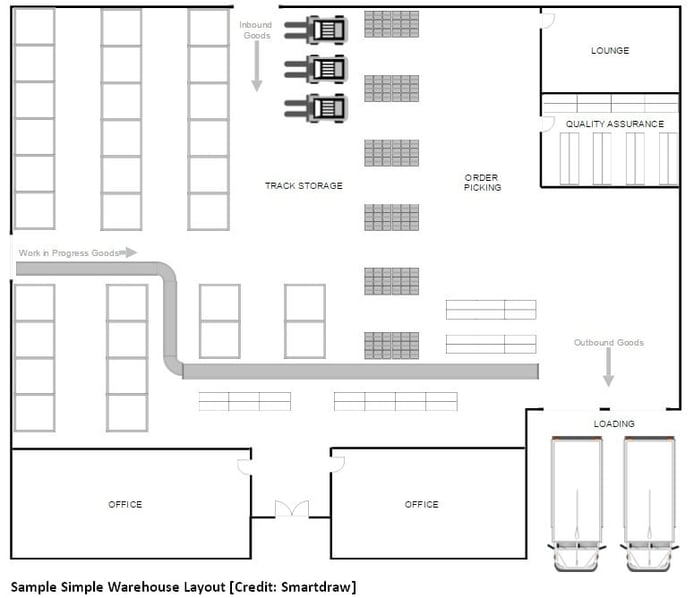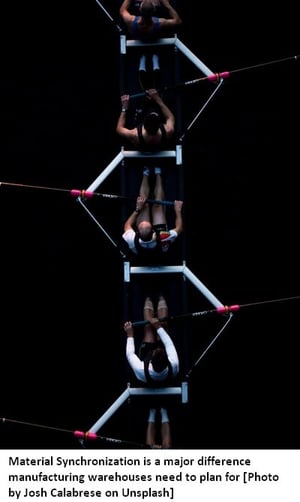
Warehouse design and management are an art form and science unto their own. 3PLs and large retailers, in particular, have taken what was once a slow-moving, unseen part of a cost-center in the business and turned it into a highly efficient, increasingly automated, carefully measured and service-focused asset. Manufacturers, on the other hand, while being at the leading edge of automation, measurement and efficiency on the production floor, may not always apply the same level of industrial design planning and management as they would normally demand.
As it turns out, warehouse operations for a manufacturing facility have a lot of similarities as other types of businesses, but do have some requirements that are unique to their needs.
Material Synchronization
Perhaps one of the most critical requirements to manage in a manufacturing warehouse is the concept of “material synchronization” (MS). As the cost of storage and holding inventory gets more expensive, material synchronization becomes a critical skill to manage, and it requires optimizing your warehouse design and your supporting equipment used for moving materiel. The potentially huge efficiencies and cost savings from material synchronization help to enable Kanban techniques like Lean manufacturing, Just-In-Sequence manufacturing, Just-In-Time inventory and others.

Supply chains are complex things, so the explanation on why keeping lower levels of inventory is not simple enough to cover here (though it would make a good White Paper in the future!). But think of it as essentially optimizing the link between demand and supply. Classic lean wisdom says that “when stock level is excessively high, problems are hidden behind the stocks” because pressure to improve supply chain responsiveness by reducing manufacturing lead time or improving overall material flow synchronization is reduced. One example is the relative competitiveness of US, Japanese and Korean automobile manufacturers as US manufacturers tend to keep higher dealer stock than their Asian counterparts. One cultural driver for those manufacturers is the requirement to do everything in smaller spaces, but Korean and Japanese manufacturers also make a large percentage of their cars in their domestic market on a custom order basis, as the dealers in their more urbanized countries might only carry floor models from which to decide before ordering. This has been one of the major differences in competitiveness between US and Japan automotive companies.
How does material synchronization work in these two situations? In the Asian model, it’s somewhat ideal as much of the movement of parts and materiel is driven by real-time demand. Of course they still require forecasting skills – the lengthy supply chain of an auto manufacturer needs to plan too. But it also means that the factory warehouse only needs to carry a small amount of the inventory needed for the real-time demand already in the pipeline and can store or produce additional inventory elsewhere – often at the supplier’s factory, who may be practicing the same technique.
When you are “blessed” (or cursed?) with huge open spaces where land is cheap and large warehouses can be added easily, the temptation is to carry more inventory so production will have it on hand and never have shortages. But then the manufacturer is subject to changes in demand which may result in waste, as well as reduced service levels to fulfill orders that differ from what was originally planned in the forecast.
Some Warehouse Management Systems (WMS) include modules for helping to manage this. A typical list of setting and parameters is a good illustration of the elements involved in MS:
- Items (Materiel) to Synchronize
- Purpose of Items
- MS Method (Earliest Supply vs Closest Supply)
- MS Area (Level at which orders are made – site, facility, division or company)
- Synchronize – generate links between supplies and the demands on them
- Shortage checks
- Lead Time Handling
- Tolerances (by percentage or quantity, etc.)
Minimizing the amount of inventory on-hand, but maintaining a system that ensures you don’t have shortages, optimizes your cycle time and brings the warehouse in line with a more demand-driven strategy that synchs better with the production floor.
Some Other More Familiar Major Factors
With Material Synchronization being perhaps the biggest difference between a typical retailer or 3PL warehouse and a manufacturers warehouse, most of the other warehouse functions will look familiar, but with their own twist customized for the specific needs in manufacturing.
Receiving and Putaway – Unlike most typical Distribution Centers, the most efficient production facilities must account for the possibility that shipments coming into the Receiving dock may never go to storage, but right to the production floor. In fact, they may need to account for both scenarios depending on time of day, products involved, etc. So design will matter in terms of providing a direct path from the Receiving docks as well as possibly eliminating or combining labels used.
Picking – Like most typical warehouses, picking processes can vary greatly depending on the business, but for manufacturers it can sometimes need to look like a kitting operation but massively scaled up to match batch sizes or other method for grouping products together. A single pick wave might be about everything needed for the entire day, or for a single hour, or for a specific number of finished products not framed by a time limitation.
Quality Control and Testing – While the typical retailer will most likely have QC limited to being an offshoot of their Receiving process, the manufacturer might have quality control at dozens of places throughout the entire production process. Receiving might have QC that inspects preliminary quality of incoming materiel or parts, but then there will be additional checks throughout the floor with some being comprehensive (inspect/test EVERY product) and some more of a random sampling. In many cases, some product will get diverted from shipping for more thorough user-readiness testing as well. While the WAREHOUSE portion of the manufacturing operation might not have a QC process that differs too much from more typical warehouses, they will be performing QC going in AND out of the facility.
Getting Green and Clean
 Finally, one additional major difference you might see in a manufacturing warehouse is the influence of the effort to make manufacturing both greener and cleaner. Pressurization of the air to meet clean standards, trends in moisture control, more redundancy in plumbing, electrical and ventilation systems and comprehensive efforts to reduce environmental impacts are emphasized more when a warehouse is part of a manufacturing facility. This also often means that there will be a higher initial cost to setting up, but with a lower total cost in mind that justifies the investment. The trend also means that rather than retrofitting older buildings for a new facility, building out a brand new one designed for the specific task can often be cheaper.
Finally, one additional major difference you might see in a manufacturing warehouse is the influence of the effort to make manufacturing both greener and cleaner. Pressurization of the air to meet clean standards, trends in moisture control, more redundancy in plumbing, electrical and ventilation systems and comprehensive efforts to reduce environmental impacts are emphasized more when a warehouse is part of a manufacturing facility. This also often means that there will be a higher initial cost to setting up, but with a lower total cost in mind that justifies the investment. The trend also means that rather than retrofitting older buildings for a new facility, building out a brand new one designed for the specific task can often be cheaper.
What are some of the differences you see in your business among the numerous facilities called “warehouses”? And what are the best practices you see in one space that might be leveraged in the others that hasn’t been considered because of its differing purpose? As demand for speed in every facet of the logistics and DC industry continues to grow, its prudent to consider how your existing facility would look and perform in the coming years as speed brings more integration up and down the supply chain. What you see on the manufacturing floor today might be a sensible solution in the DC of tomorrow too.